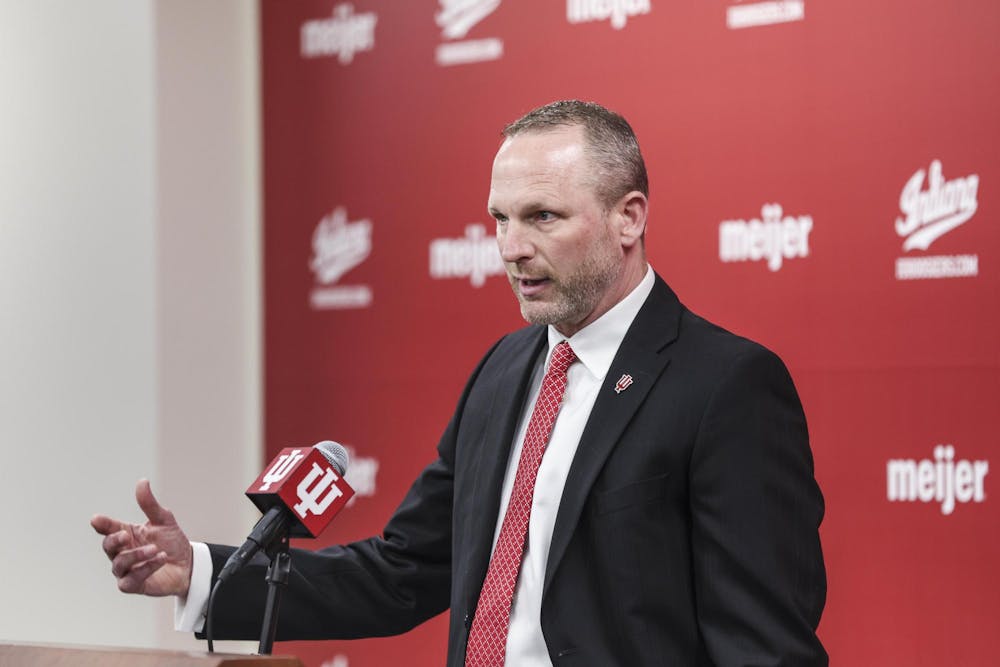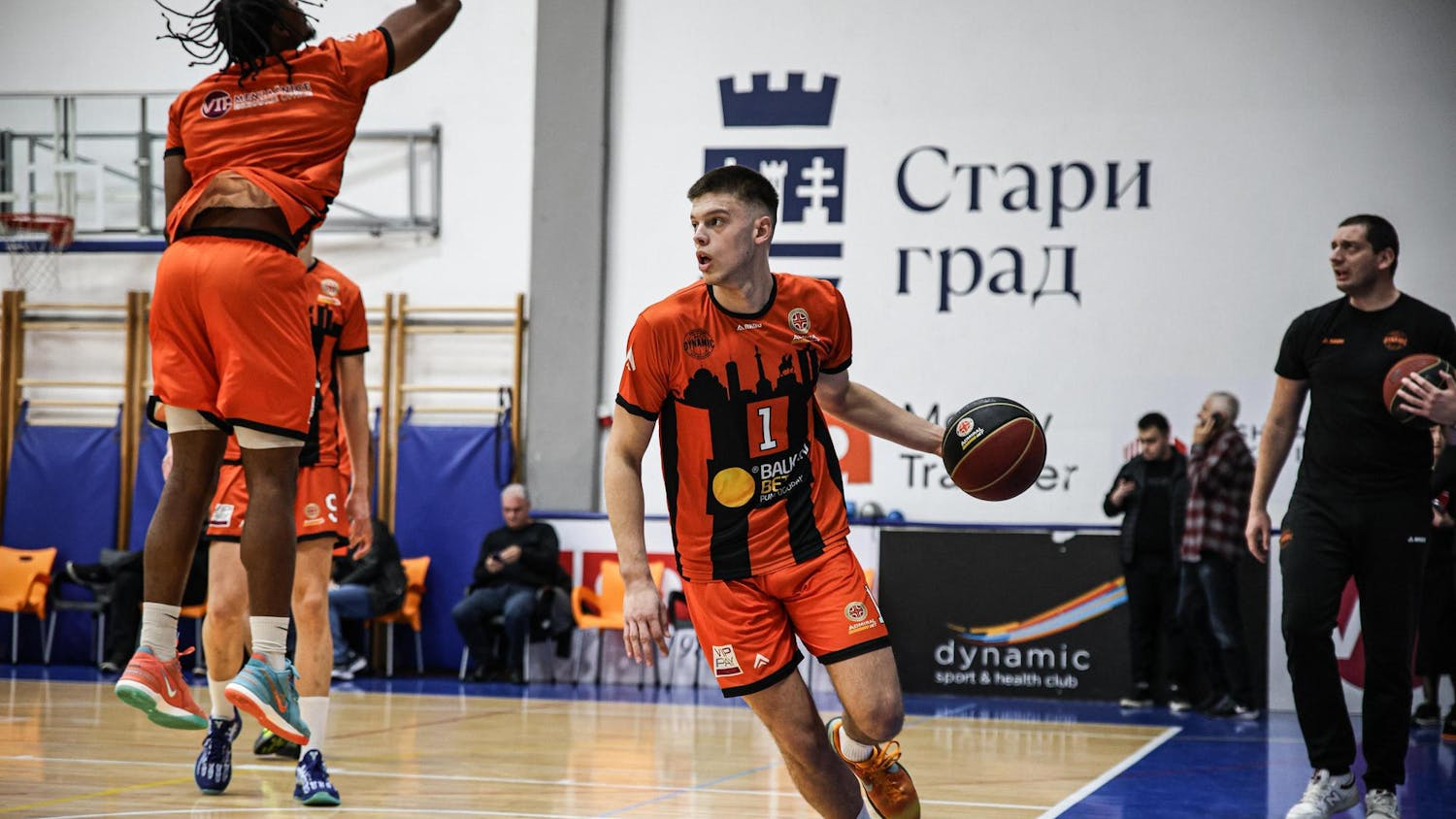BORDEN, Ind. — Darian DeVries has more resembled a tour guide than a head basketball coach in his first two-plus months leading the Indiana men’s basketball program, but his efforts produced a roster he feels can compete this season.
DeVries doesn’t know the heights his first Hoosier squad can reach. Indiana has 11 players currently signed to its roster with its first practice looming June 2, and DeVries said he’ll know much more about the strengths and weaknesses of his team as summer progresses.
The 50-year-old DeVries, who spoke with reporters Wednesday at Huber’s Winery in Borden, Indiana, for an NIL event, likes how the Hoosiers’ roster projects.
“I think we got great depth in shooting the basketball, which is a priority for us,” DeVries said. “I think, for the most part, we got good positional size at a lot of spots. At center, we’re a little smaller, but every other spot I think we got some great size. And I think overall we’ve got great depth.”
DeVries, whose roster-building philosophy places an emphasis on high school recruiting and retention, had to craft Indiana’s roster primarily through the transfer portal. Left with no returning players, DeVries retained one high school recruit — four-star forward Trent Sisley — while adding 10 transfers.
The Hoosiers signed six seniors in guards Lamar Wilkerson, Tayton Conerway and Conor Enright and forwards Tucker DeVries, Reed Bailey and Sam Alexis. They also added junior guard Jason Drake and wings Jasai Miles and Nick Dorn, along with sophomore forward Josh Harris.
Five of Indiana’s 10 transfers shot at least 35% from 3-point range last season, while three — Wilkerson, Tucker DeVries and Bailey — eclipsed 40%. The Hoosiers collectively shot 32.1% from distance last season, which ranked third-worst in the Big Ten.
However, what Indiana gains in shooting will be lost in size. After rostering six players 6-foot-9 or taller last season, they enter 2025 with only one. The 6-foot-10 Bailey will be the closest thing to a true center for the Hoosiers following Oumar Ballo’s departure.
Darian DeVries acknowledged Indiana is undersized and may not have high-end rim protection defensively, but he noted there are several ways to protect the rim that don’t include blocking shots.
The Hoosiers’ roster is built more on versatility and shooting than sheer size and physicality, a notable difference from previous head coach Mike Woodson’s tenure. Woodson valued inside-out offenses with a post-heavy style. DeVries wants to play more up-tempo and hit shots from the perimeter.
Still, DeVries likes Indiana’s interior pieces in Bailey and a pair of 6-foot-8 players in Harris and Alexis. DeVries admitted there will be nights the Hoosiers are undersized defensively, but he said size doesn’t always dictate effectiveness in the paint — mindset does. He believes his group’s mindset can help offset any height or weight deficiencies.
“I feel really good about the five,” DeVries said. “I like the guys we have. I think they fit how we want to play offensively especially. I think they have the ability to really have the ball in their hands and be facilitators and playmakers.”
Indiana still has two scholarships available, which DeVries implied will go to senior wing Luke Goode and guard Anthony Leal, each of whom played for the Hoosiers last season. Goode and Leal are awaiting news from the NCAA on waivers to receive another year of eligibility.
“That’s why we’ve kind of held back a couple scholarships here, trying to see where this process plays out for them and then you make decisions based off that,” DeVries said. “Hopefully we’ll have a better idea on the timing of that stuff sooner than later to see where that all falls.”
It’s unclear when the NCAA will make its decision on Goode and Leal, but the Hoosiers are actively recruiting other players in the transfer portal as backup options. Plan A, however, appears to center on the two Indiana natives returning for another season in Bloomington.
Goode and Leal are familiar faces to Hoosier Nation, but the 11 signees aren’t. DeVries is in a similar position. Only two players — his son, Tucker, and Enright — have been with DeVries previously.
DeVries said the biggest challenge he faced building his roster was ensuring each player aids his goal of establishing an early identity for his tenure. With short recruiting windows and the pressure to add pieces to his team, DeVries had to gauge character quickly in his interactions with recruits, be it getting food or showing them around campus.
Toss in the extensive process of filling out his coaching staff, and DeVries was in an uphill battle with a high-pressure time crunch. He said he didn’t take any shortcuts and tried to approach it in a smart, calculated manner.
To vet recruits’ character, DeVries tapped into a wealth of contacts — not only his own, but also his assistants — while gathering information about each player. It’s a fast-moving procedure with players often committing anywhere from two to four weeks after entering the transfer portal, but DeVries is confident in his process.
“For the most part, you have a pretty good idea (of players) as you’ve been out recruiting, watching these kids come through the high school ranks, go through the college ranks,” DeVries said. “And there’s always somebody you can touch that has a really good feel for what the kid’s about.”
DeVries will get more time than usual to learn about his team this summer. NCAA rules restrict coaches to four hours of skill-related instructions per week, but with Indiana playing three games in August in Puerto Rico, the Hoosiers get 10 additional practices.
The opportunity expands the window for DeVries to watch film and instill principles within his players. Perhaps most importantly, it gives the Hoosiers time to jell, an invaluable asset for a roster full of players who currently know little about one another.
Indiana’s new-look team hasn’t yet made its first full-squad appearance in Simon Skjodt Assembly Hall. It hasn’t held a team meeting. Players won’t arrive until this weekend.
But after two months of phone calls with players and giving tours of a town he doesn’t fully know, DeVries is optimistic Indiana has the assets necessary to win in his first season.
“I think overall on paper, I like the balance we have,” DeVries said. “I think there’s a lot of things we can play to and try to have as strengths. Again, that comes down to — we got to take it from paper to the floor. And that’s that process that starts here next week.”




